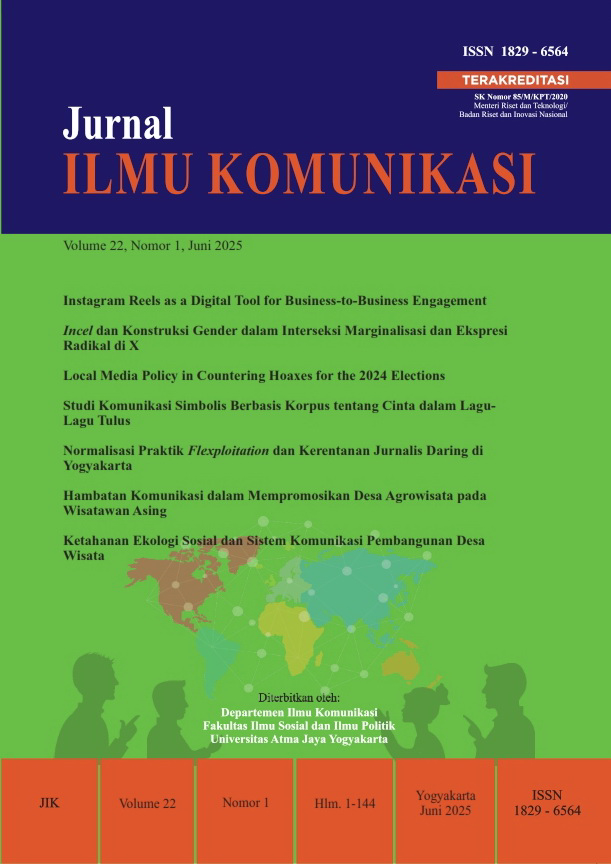Hambatan Komunikasi dalam Mempromosikan Desa Agrowisata pada Wisatawan Asing
DOI:
https://doi.org/10.24002/jik.v22i1.9433Keywords:
communication barriers, foreign tourists, Tamanmartani, tourist villageAbstract
Tamanmartani Village in Yogyakarta has great potential to attract foreign tourists, but faces communication barriers. This study identified challenges such as limited information, language barriers, different perceptions of tourism development, as well as difficulties finding local guides and managing social media. Data were collected through observation and interviews with managers, residents, and foreign tourists. Results showed three communication barriers: the manager's limited knowledge of marketing communication, promotional materials for foreign tourists, and the unfamiliarity of foreign tourists with the local culture. Overcoming these barriers is essential to support the sustainable growth of tourism businesses and improve interactions with foreign tourists.
References
Abdussamad, H. Z. (2021). Metode penelitian kualitatif. Makassar, Indonesia: CV. Syakir Media Press.
Abidin, J., Fedrina, R., & Agustin, R. (2022). Penguatan kelembagaan desa wisata melalui promosi digital marketing di desa cisaat, kecamatan ciater, kabupaten subang. Jurnal Abdimas Pariwisata, 3(1), 1–10.
Adinda, S., & Pangestuti, E. (2019). Pengaruh media sosial instagram@ exploremalang terhadap minat berkunjung followers ke suatu destinasi: Survey pada followers @exploremalang. Jurnal Administrasi Bisnis, 72(1), 176-183.
Anwar, R. (2018). Hambatan komunikasi antarbudaya di kalangan pelajar asli Papua dengan siswa pendatang di kota Jayapura. Jurnal Common, 2(2), 139 - 149.
Asfina, R., & Ovilia, R. (2017). Be proud of Indonesian cultural heritage richness and be alert of its preservation efforts in the global world. Humanus, 15(2), 195-206.
Cahyono, A. S. (2016). Pengaruh media sosial terhadap perubahan sosial masyarakat di Indonesia. Publiciana, 9(1), 140–157.
Dolezal, C., Trupp, A., & Bui, H. T. (2020). Tourism and development in southeast asia: Concluding remarks and future outlook. In Claudia Dolezal, Alexander Trupp, Huong T. Bui (Eds), Tourism and Development in Southeast Asia, p. 214–218. London, UK: Routledge.
Hung, K., Li, X., Pan, B., & Petrick, J. F. (2010). Knowledge dissemination in tourism education: A case of tourism marketing. Journal of Travel and Tourism Marketing, 27(5), 519-532.
Indika, D. R., & Jovita, C. (2017). Media sosial instagram sebagai sarana promosi untuk meningkatkan minat beli konsumen. Jurnal Bisnis Terapan, 1(01), 25–32.
Infopublik.id. (2024). Kemenkraf RI: Pengembangan desa wisata tamanmartani harus didukung antar lembaga. <https://infopublik.id/kategori/nusantara/835519/kemenkraf-ri-pengembangan-desa-wisata-tamanmartani-harus-didukung-antarlembaga>.
Krzyżanowska, K., & Wawrzyniak, S. (2020). The effectiveness of sources of information on rural facilities and agritourism. Annals of the Polish Association of Agricultural and Agribusiness Economists XXII(2), 134–41.
Listiawan, A. A., & Rusdianto, R. Y. (2023). Analisis potensi agrowisata di desa Pandean, kecamatan Gondang, kabupaten Nganjuk, Jawa Timur. Madani: Jurnal Ilmiah Multidisiplin, 1(7), 124-129.
Mahmoodi, M., Roman, M., & Prus, P. (2022). Features and challenges of agritourism: Evidence from Iran and Poland. Sustainability, 14(8), 4555.
Mazlan, N., & Juraimi, A. S. (2014). Development and challenges of agritourism in Malaysia. J. ISSAAS, 20(1), 131-138.
Miller, K., Settle, Q., King, A. E., & Kisling, B. (2023). How agritourism operators make marketing and promotion decisions. Journal of Human Sciences and Extension, 11(1), 1-15. https://doi.org/DOI: https://doi.org/10.55533/2325-5226.1377
Nurdiani, N., Hendarti, R., & Tedja, M. (2020). Physical quality of creative economic space on cultural tourism areas in java island. IOP Conference Series: Earth and Environmental Science, 452(1), 1-5.
Palazzo, M., Gigauri, I., Panait, M. C., Apostu, S. A., & Siano, A. (2022). Sustainable tourism issues in european countries during the global pandemic crisis. Sustainability, 14(7), 1-21.
Parlindungan, H. H., Sukwika, T., & Manurung, H. (2021). Prambanan temple tourist destination development in indonesia as world cultural heritage. European Journal of Science, Innovation and Technology, 1(3), 39-56.
Lantiva, M. C.. (2021). Mengenal obwis desa kalurahan tamanmartani. Radar Jogja. <https://radarjogja.jawapos.com/bantul/65748881/mengenal-obwis-desa-kalurahan-tamanmartani>
Miles, M. B., Huberman, A. M., & Saldana, J. (2014). Qualitative data analysis: A method sourcebook. California, USA: Sage Publications
Rusli, M. (2021). Merancang penelitian kualitatif dasar/deskriptif dan studi kasus. Jurnal Pendidikan dan Studi Islam, 2(1), 48–60.
Sistem Informasi. (n.d). Demografi berdasar jenis kelamin. Tamanmartani.id.< <https://tamanmartani.id/first/statistik/4>
Tamanmartanisid. (n.d) Gambaran umum dan kondisi kalurahan Tamanmartani. <https://tamanmartanisid.slemankab.go.id/assets/files/dokumen/GAMBARAN%20UMUM.pdf>
Utama, I. G. B. R., & Junaedi, I. W. R. (2015). Agrowisata Sebagai pariwisata alternatif indonesia: Solusi masif pengentasan kemiskinan. Yogyakarta, Indonesia: Deepublish.
Utami, D. D., Dhewanto, W., & Lestari, Y. D.. (2023). Rural Tourism Entrepreneurship Success Factors for Sustainable Tourism Village: Evidence from Indonesia. Cogent Business & Management, 10(1), 1-21.
Winarto, S., Niswaty, R., & Jamaluddin, J. (2015). Strategi pengembangan daya tarik wisata balla lompoa di kabupaten gowa provinsi sulawasi selatan. Ad’ministrare, 2(2), 94–100.
World Travel & Tourism Council. (2022). More than five million new travel & tourism jobs to be created in Indonesia within the next decade. wttc.org. <https://wttc.org/news-article/more-than-five-million-new-travel-and-tourism-jobs-to-be-created-in-indonesia-within-the-next-decade>
Yusuf, M. (2020). How far can tourism go? residents’ attitudes toward tourism development in yogyakarta city, indonesia. Indonesian Journal of Geography, 52(2), 208-218.
Downloads
Published
How to Cite
Issue
Section
License

This work is licensed under a Creative Commons Attribution 4.0 International License.
Jurnal ILMU KOMUNIKASI is an academic journal. As such, it is dedicated to the open exchange of information. For this reason, JIK is freely available to individuals and institutions. Authors who publish in Jurnal ILMU KOMUNIKASI will release their articles under the Creative Commons Attribution (BY) License. This license allows anyone to copy and redistribute the article in any medium or format as well as remix, transform, and build upon the material for any purpose, even commercially as long as they credit the authors for the original creation. For details of the rights authors grants users of their work, see the "human-readable summary" of the license, with a link to the full license. (Note that "you" refers to a user, not an author, in the summary)
 This work is licensed under a Creative Commons Attribution 4.0 International License.
This work is licensed under a Creative Commons Attribution 4.0 International License.














